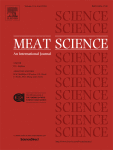Ver ítem
- xmlui.general.dspace_homeCentros Regionales y EEAsCentro Regional Buenos Aires SurEEA BalcarceArtículos científicosxmlui.ArtifactBrowser.ItemViewer.trail
- Inicio
- Centros Regionales y EEAs
- Centro Regional Buenos Aires Sur
- EEA Balcarce
- Artículos científicos
- Ver ítem
Genetic and management factors affecting beef quality in grazing Hereford steers
Resumen
Attributes contributing to differences in beef quality of 206 Hereford steers finished on pasture were assessed. Beef quality traits evaluated were: Warner–Bratzler meat tenderness and muscle and fat color at one and seven days after slaughter and trained sensory panel traits (tenderness, juiciness, flavor, and marbling) at seven days. Molecular markers were CAPN1 316 and an SNP in exon 2 on the leptin gene (E2FB). Average daily live weight gain,
[ver mas...]
Attributes contributing to differences in beef quality of 206 Hereford steers finished on pasture were assessed. Beef quality traits evaluated were: Warner–Bratzler meat tenderness and muscle and fat color at one and seven days after slaughter and trained sensory panel traits (tenderness, juiciness, flavor, and marbling) at seven days. Molecular markers were CAPN1 316 and an SNP in exon 2 on the leptin gene (E2FB). Average daily live weight gain, ultrasound monthly backfat thickness gain and rib-eye area gain were estimated. Molecular markers effects on meat quality traits were analyzed by mixed models. Association of meat quality with post weaning growth traits was analyzed by canonical correlations. Muscle color and marbling were affected by CAPN1 316 and E2FB and Warner–Bratzler meat tenderness by the former. The results confirm that marker assisted selection for tenderness is advisable only when beef aging is a common practice. The most important sources of variation in tenderness and color of meat remained unaccounted for.
[Cerrar]

Autor
Melucci, Lilia Magdalena;
Panarace, M.;
Feula, P.;
Villarreal, Edgardo Leopoldo;
Grigioni, Gabriela Maria;
Carduza, Fernando Jose;
Soria, Liliana A.;
Mezzadra, Carlos Alberto;
Arceo, Maria E.;
Papaleo Mazzucco, Juliana;
Corva, Pablo Marcelo;
Irurueta, Martin;
Rogberg Muñoz, Andres;
Miquel, María Cristina;
Fuente
Meat Science 92 (4) : 768-774 (December 2012)
Fecha
2012-12
Editorial
Elsevier
ISSN
0309-1740
Formato
pdf
Tipo de documento
artículo
Palabras Claves
Derechos de acceso
Restringido
 Excepto donde se diga explicitamente, este item se publica bajo la siguiente descripción: Creative Commons Attribution-NonCommercial-ShareAlike 2.5 Unported (CC BY-NC-SA 2.5)
Excepto donde se diga explicitamente, este item se publica bajo la siguiente descripción: Creative Commons Attribution-NonCommercial-ShareAlike 2.5 Unported (CC BY-NC-SA 2.5)

